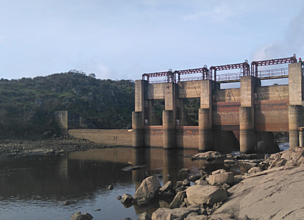Removing tens of thousands of obsolete dams in Europe would bring rivers back to life, says new report
With only 40 percent of Europe’s waterways in good condition, a new study published today calls for the removal of tens of thousands of redundant dams and other barriers across the continent to help restore rivers and lakes, which will boost wildlife populations and benefit communities.

Yecla de Yeltes Dam in Spain was removed in April 2018
The study titled Dam Removal: A viable solution for the future of our European Rivers reveals that the density of dams, weirs and locks in Europe is far higher than previously suspected, with salmon, eel, sturgeon and other migratory fish encountering obstacles every kilometre of their journey on average. Previously, only dams higher than 10 metres were counted, but these represent less than 3 per cent of all river barriers.
“Dams have played a critical role in Europe’s development but they have also contributed to the slow death of our rivers and the catastrophic decline in freshwater species,” said Stuart Orr, WWF Leader, Freshwater Practice. “Tens of thousands of small dams and barriers are no longer in use but they are still in place: blocking fish migrations, stopping the flow of sediment and nutrients, and undermining the value of rivers to people and nature.”
The report estimated that in France, Spain, Poland and the UK alone, there are up to 30,000 mainly small dams which are now obsolete. No comprehensive study currently exists on the total number of obsolete dams in Europe, but this figure is likely to be much higher.
While these barriers provide no benefits to communities, they still prevent rivers from flowing freely, contributing to the disappearance of freshwater species, particularly migratory fish that can no longer reach their spawning grounds. This also affects birds that feed on fish as well as many other animals.
The report calls for governments across Europe to start removing these redundant dams to help breathe life back into river systems and provide new opportunities for local economies. Dam removals will also enable Member States to meet their commitments under the EU Water Framework Directive (WFD), under which all countries must achieve good status for the majority of their water bodies, including rivers, lakes and wetlands, by 2027.
“Nature can recover remarkably fast when given the chance: dam removals in Europe have seen fish immediately returning to rivers for the first time in decades and existing species multiplying rapidly,” said Peter Gough from World Fish Migration Foundation, one of the authors of the report. “As the fish return so do the fish-eating birds and a wealth of other species dependent on healthy river systems and wetlands. It also brings back fishers and birdwatchers, giving rural areas a new lease of life”.
Dam removals have slowly started to pick up the pace in Europe, and the Water Framework Directive’s ambitious goals, timeline, and visionary approach to water management have been instrumental.
The report lists a series of case studies that illustrate the remarkably rapid impact of dam removals. In the Netherlands, after two weirs were removed from the ‘Boven Slinge’ stream in 2015, the number of fish species in the newly connected stretches increased by an average of 30 per cent and the number of individual animals increased by 148 per cent. In nearby Denmark, the removal of a dam on the Gudenå river saw trout numbers upstream rise from zero to 4-5 per m2. Meanwhile, the removal of the Maisons-Rouges dam in France in 1999 has resulted in a spectacular surge in fish numbers with sea lamprey numbers soaring from barely any to over 41,000 within eight years.
“Dam removal has proven to be a very eco-efficient and cost-effective measure to reach the objectives of the Water Framework Directive to which all member states have committed themselves to”, said Orr. “It is also significantly cheaper than maintaining aging, obsolete dams. Freeing rivers offer additional advantages including cleaning water naturally, boosting tourism numbers and restoring a river’s natural flood defences, which is critical in the age of climate change.”
The report’s launch comes ahead of the EU’s public consultation of the WFD, which is part of its standard review, and will be held later this year. While studies show that dam removal is a viable solution, there is an urgent need for all small and large dams in Europe to be mapped and prioritise removal of obsolete one. The report also calls for dam removals to be integrated into Member States’ River Basin Management Plans, involving local communities in dam removal, and seriously considering alternatives to dam building.
Source: World Wildlife Fund
- 259 reads
Human Rights
Ringing FOWPAL’s Peace Bell for the World:Nobel Peace Prize Laureates’ Visions and Actions

Protecting the World’s Cultural Diversity for a Sustainable Future

The Peace Bell Resonates at the 27th Eurasian Economic Summit

Declaration of World Day of the Power of Hope Endorsed by People in 158 Nations

Puppet Show I International Friendship Day 2020

